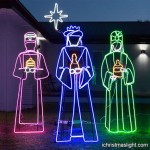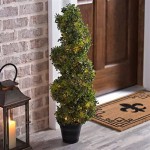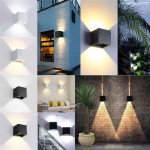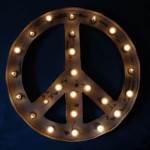Outdoor Emergency Exit Lights With Battery Backup: Guiding the Way to Safety
Outdoor emergency exit lights with battery backup are critical safety devices designed to provide illumination and directional guidance during emergency situations, particularly when normal power sources are disrupted. These lights are engineered to withstand harsh outdoor conditions and offer a reliable source of light, ensuring occupants can safely evacuate a building or outdoor area during power outages caused by storms, fires, or other unforeseen events. They are a fundamental component of a comprehensive emergency preparedness plan, contributing to a safer and more secure environment for employees, residents, and visitors.
These lighting systems are not merely accessories; they are life-saving tools that meet stringent regulatory requirements outlined by building codes and safety standards. Compliance with these regulations is essential for ensuring the safety of individuals and avoiding potential legal liabilities. The strategic placement and proper maintenance of outdoor emergency exit lights with battery backup are crucial for their effectiveness. They must be readily visible, clearly indicating the path of egress, and maintained in optimal working condition to guarantee performance during critical moments.
The functionality of these lights hinges on their ability to immediately switch to battery power when the primary power supply fails. This seamless transition ensures uninterrupted illumination, allowing individuals to navigate safely through darkened or obscured areas. The battery backup system is designed to provide sufficient power for a specified duration, as mandated by safety standards, giving occupants ample time to evacuate the premises safely.
The Importance of Durability and Weather Resistance
Outdoor emergency exit lights are exposed to a variety of environmental challenges, including extreme temperatures, rain, snow, dust, and UV radiation. To withstand these conditions, they are constructed from robust materials such as die-cast aluminum, polycarbonate, or durable plastics. These materials are chosen for their resistance to corrosion, impact, and degradation from prolonged exposure to the elements. The housings are often sealed to prevent moisture and dust ingress, ensuring the internal components remain protected and the lights function reliably even under adverse weather conditions.
The ingress protection (IP) rating is a critical indicator of the light's ability to withstand the intrusion of solids and liquids. An outdoor emergency exit light should have a suitable IP rating, such as IP65 or higher, to ensure it is protected from dust and water jets. This rating signifies that the light can withstand exposure to rain or splashes without compromising its functionality. Selecting lights with appropriate IP ratings is paramount for ensuring their longevity and performance in outdoor environments.
Furthermore, UV resistance is a crucial factor, especially in areas with high levels of sunlight. Prolonged exposure to UV radiation can cause plastic components to become brittle and discolored, which can reduce the light's visibility and structural integrity. UV-stabilized materials are often used in the construction of these lights to mitigate the effects of UV radiation and ensure they retain their functionality and appearance over time.
Key Features and Functionality
Outdoor emergency exit lights with battery backup incorporate several key features that contribute to their effectiveness and reliability. These features include high-intensity LEDs, automatic self-testing capabilities, and extended battery life. The use of LEDs (light-emitting diodes) has revolutionized emergency lighting due to their energy efficiency, long lifespan, and ability to provide bright, uniform illumination. LEDs consume significantly less power than traditional incandescent or fluorescent bulbs, allowing for longer battery backup times and reduced energy costs.
Automatic self-testing is another crucial feature that ensures the lights are always in optimal working condition. These systems periodically test the battery, the light source, and the charging circuit to identify any potential problems. If a fault is detected, the light will typically indicate the issue through visual or audible alerts, allowing for timely maintenance and repairs. This proactive approach minimizes the risk of failure during an emergency.
The battery backup system is the heart of these emergency lights. The batteries used are typically nickel-cadmium (Ni-Cd) or nickel-metal hydride (Ni-MH) batteries, known for their reliability and long lifespan. The battery capacity is selected to provide a minimum of 90 minutes of illumination, as required by most building codes. However, some applications may require longer backup times, depending on the specific needs of the facility. It is essential to choose batteries that are specifically designed for emergency lighting applications and to follow the manufacturer's recommendations for charging and maintenance to ensure optimal performance and longevity.
Regulatory Compliance and Installation Considerations
Compliance with relevant building codes and safety standards is mandatory for all outdoor emergency exit lights with battery backup. These regulations are designed to ensure the safety of building occupants and to provide a minimum level of performance during emergency situations. In the United States, the National Fire Protection Association (NFPA) and Underwriters Laboratories (UL) are the primary organizations that set standards for emergency lighting. NFPA 101, the Life Safety Code, provides guidelines for the design, installation, and maintenance of emergency lighting systems. UL 924 is the standard for emergency lighting and power equipment, specifying the performance requirements for emergency exit lights and related devices.
Proper installation is critical for ensuring the effectiveness of outdoor emergency exit lights. The lights should be installed in accordance with the manufacturer's instructions and the applicable building codes. They should be strategically located along the path of egress, providing clear and easily visible directional guidance. The spacing between lights should be determined based on the illumination levels required and the visibility conditions in the area. Mounting height and angle should also be carefully considered to ensure the lights are readily visible from all angles.
Regular inspection and maintenance are essential for ensuring the continued reliability of outdoor emergency exit lights. A comprehensive maintenance program should include periodic testing of the lights, battery replacements as needed, and cleaning of the light fixtures to remove dirt and debris. Records of all inspections and maintenance activities should be maintained to demonstrate compliance with regulatory requirements.
Choosing the right type of outdoor emergency exit light requires a careful assessment of the specific needs of the facility and the environmental conditions in the area. Consideration should be given to factors such as the size of the area to be illuminated, the level of ambient light, the expected weather conditions, and the applicable building codes. Consulting with a qualified lighting professional can help ensure that the selected lights meet all the requirements for safety and performance.
Emergency exit lights are not just about providing light; they are about providing a safe and orderly evacuation during times of crisis. By selecting and maintaining these lights according to best practices, organizations can significantly enhance the safety and security of their premises. A well-designed and properly maintained emergency lighting system is a crucial investment in the well-being of all occupants.
The evolving landscape of technology continues to influence the design and functionality of emergency exit lights. Innovations such as smart lighting systems, wireless connectivity, and advanced battery technologies are paving the way for more efficient and reliable emergency lighting solutions. These advancements offer the potential to further enhance the safety and security of buildings and outdoor areas during emergency situations.

Nicor Outdoor Emergency White Led Fixture With Battery Backup Eml61unvwh The Home Depot

Wet Location Outdoor Emergency Light Ul Listed Exit Sign Warehouse

Leonlite Wet Location Red Led Exit Sign Ul Listed Exterior Outdoor Weatherproof Battery Backup Emergency Light Signs Ac 120 227v Com

Leonlite Wet Location Red Led Exit Sign Ul Listed Exterior Outdoor Weatherproof Battery Backup Emergency Light Signs Ac 120 227v Com

Leonlite Ul Listed Outdoor Led Exit Sign Light For Warehouse Mall School Wet Location Double Sided Red Exterior Emergency With Battery Backup Com

Nicor Outdoor Emergency White Led Fixture With Battery Backup Eml61unvwh The Home Depot

Nicor Outdoor Emergency White Led Fixture With Battery Backup Eml61unvwh The Home Depot

Leonlite Wet Location Red Led Exit Sign Ul Listed Exterior Outdoor Weatherproof Battery Backup Emergency Light Signs Ac 120 227v Com

Emergency Lights Elf Fl Exit Light Co

Nicor Outdoor Emergency White Led Fixture With Battery Backup Eml61unvwh The Home Depot
Related Posts







